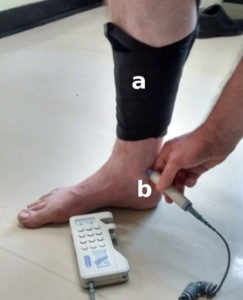In 1977, Mauro Bartolo proposed a technique for the non-invasive measurement of venous pressure which he termed the venous pressure index (VPI). This is performed standing with a flat or cylindrical duplex probe of 8 MHz which may be fixed in position over an ankle vein (GSV, SSV or posterior tibial vein). A pneumatic cuff (sphygmomanometer) is wrapped around the calf and inflated to 120 mmHg. On deflation of the cuff, the pressure at which the first venous noise is heard is defined as the VPI. It represents the resumption of flow when the venous pressure over the insonated vein is greater than the pressure of the calf-cuff. This pressure was demonstrated to be significantly greater in patients with venous disease. Though this seems a simple test, current research and opinion focuses on what is actually being measured. This depends heavily on whether the VPI is considered a static test, where inflow equals outflow, or a dynamic test during calf compression/relaxation.
The VPI may be performed supine where there is no hydrostatic column present to increase the venous pressure. In this case a high VPI may reflect the presence of an obstruction.
MAURIZIO BRUSCHI Mauro Bartolo, using continuous wave Doppler, recorded a pressure value in the posterior tibial vein on slow release of the calf-cuff. This is when antegrade venous flow first resumes. He defined this pressure as ‘venous pressure’ which gave birth the VPI.
This index was criticised because it may be more representative if the VPI was defined as the pressure required to arrest flow during the inflation of the calf-cuff rather than its release. The rationale for this argument is that calf-cuff deflation represents calf muscle relaxation or calf diastole. This adds a dynamic component to the measurement. An area of under-filled calf veins is produced waiting to receive blood from reflux/recirculation in superficial venous disease. This hydrostatic column may be more significant than the contribution from antegrade flow via the foot.
During calf muscle diastole/relaxation the presence of varicose veins usually creates, with the refluxing flow, an excess re-circulation load into the deep veins. This can be demonstrated in the femoral vein with duplex as this is a common point of registering flow which can be compared to a leg without venous disease.
The venous system has the property of high capacitance and low resistance. It could be argued, therefore, that the high VPI pressures observed in patients with varicose veins are due to an increased resistance to antegrade venous drainage. For this reason the VPI of Bartolo may be considered more as a resistance index against global venous drainage rather than a true non-invasive measure of venous pressure.
Measurement of the venous pressure index (VPI) over the posterior tibial vein using a sphygmomanometer cuff (a) and a hand held cylindrical Doppler probe (b). Debate exists as to whether the cuff should be inflated or deflated to obtain the first pressure recording.
